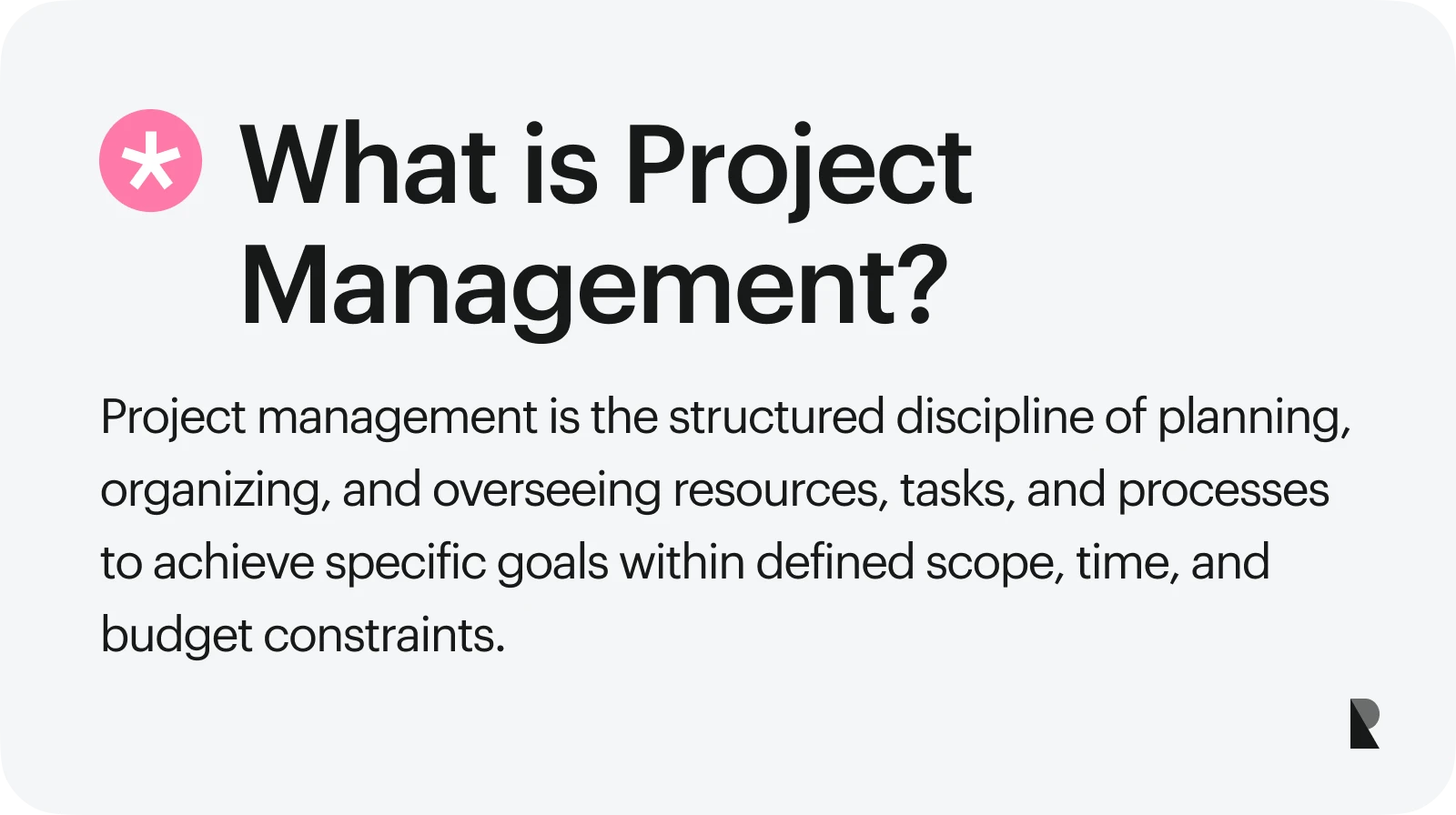
Project management is not a new concept. Its principles trace their roots back to the strategic brilliance of World War II. In the post-war boom, these principles evolved into a discipline quickly adopted by industries prone to massive cost overruns and project delays, like automotive, engineering, and construction.
Fast forward to today, and project management has become a vital component in every organization as they navigate a volatile environment. Learn the fundamentals of project management and how it can benefit your organization. You'll discover proven methodologies that can bring you closer to success.
What is Project Management and Why It Matters
Project management is a disciplined approach that combines the right tools, skills, techniques, and knowledge to meet project requirements. It is temporary, with a defined start and end, lasting until the project produces a specific result within budget.
While breaking down processes to achieve goals can be easy on paper, implementation in the field can be challenging. This is when project managers are needed, leading cross-functional teams, managing budgets, and ensuring projects are delivered on time and within budget.
As businesses navigate complex and ever-changing environments, the demand for effective project management remains high across industries.
How Project Management Impacts Business Outcomes
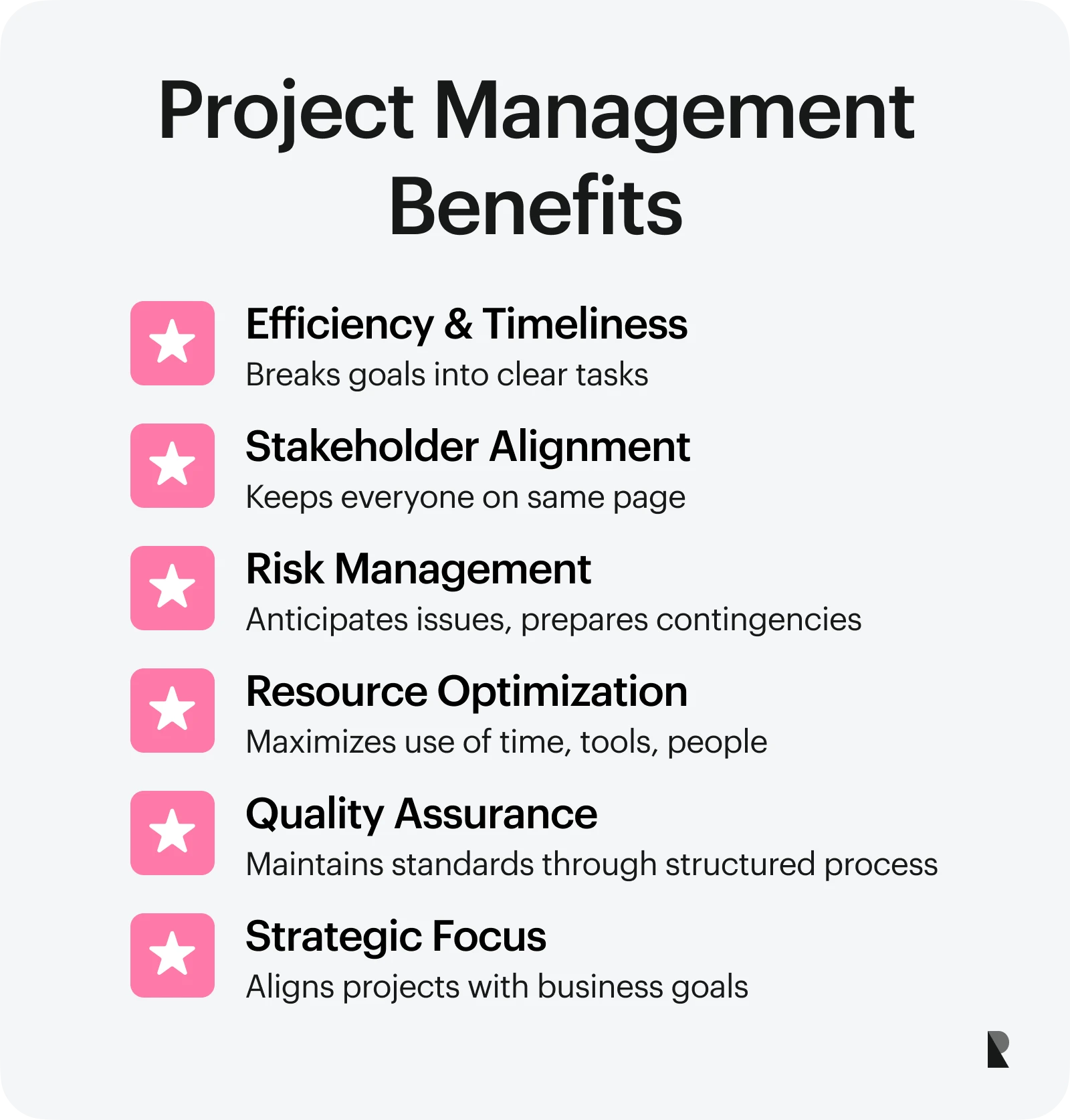
Project management is both an art and a science. It integrates the right tools, strategies, and people to achieve goals. Effective project management helps companies get organized and deliver results efficiently. It also improves planning, implementation, and overall efficiency.
Increased efficiency and timeliness
Breaking goals into smaller, achievable tasks allows teams to complete them promptly and optimize results. Project management also holds the team accountable for meeting set project expectations.
Stakeholder alignment
Project management keeps everyone on the same page through regular check-ins, progress updates, and inclusive planning. This cohesion prevents miscommunication, mistakes, and missed deadlines.
Improved risk management
Speaking of mistakes, effective project management guarantees reduced risk by proactively identifying challenges before they occur. It encourages project management teams to develop contingency plans, which are crucial in maintaining a competitive advantage in a volatile environment.
Project Management vs. Product Management
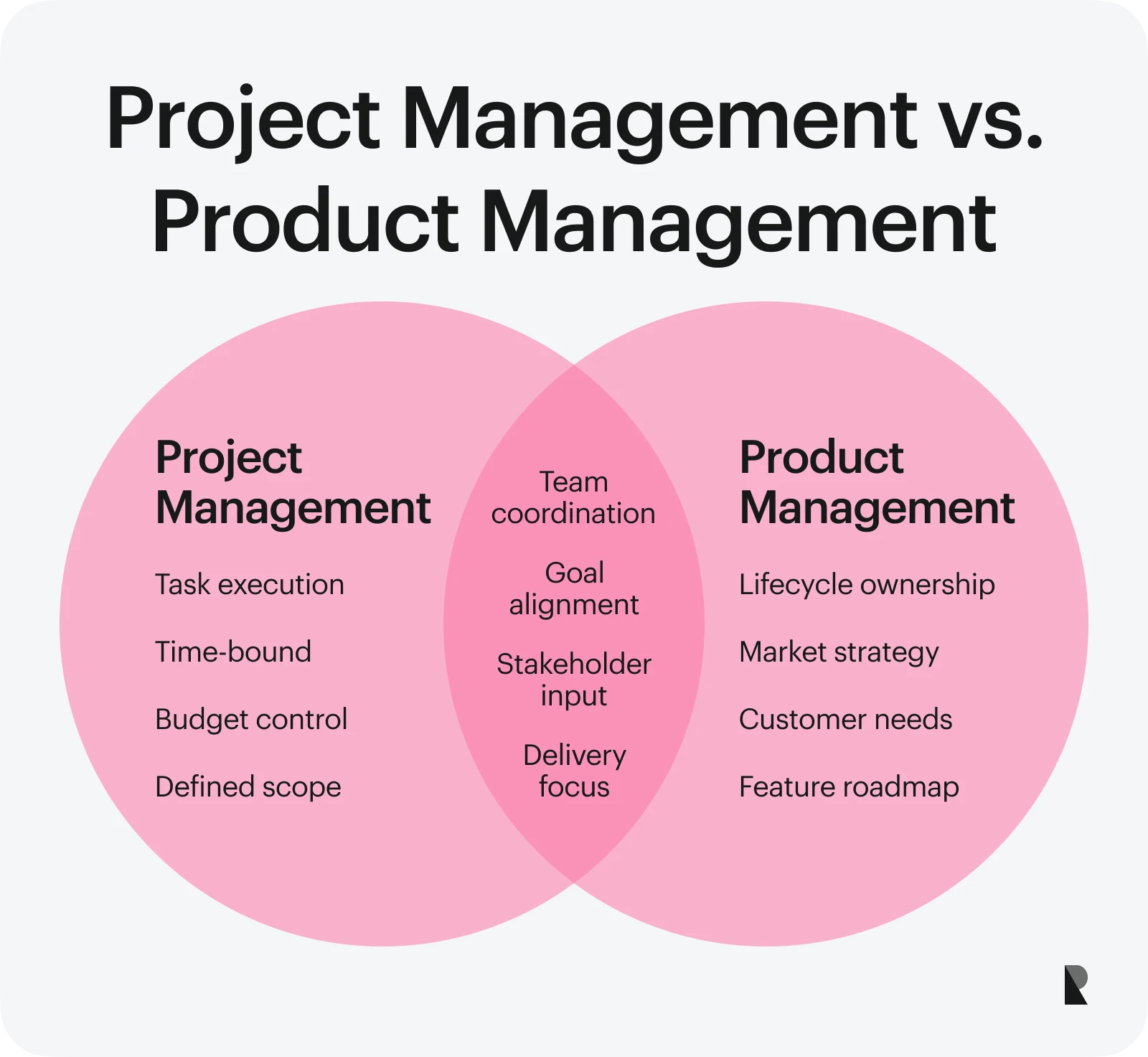
Product management and project management serve distinct but complementary roles.
Product management focuses on the entire product lifecycle, from ideation and development to launch, monitoring, and improvements. It determines what new product is needed to meet customer needs and business objectives.
Project management supports product management by efficiently delivering on defined project goals. The project management team is responsible for identifying actions, assigning tasks, setting deadlines, and ensuring all necessary elements are delivered on time for the product launch.
For example, the product management team decides on the soda flavor mix for a younger demographic. In contrast, the project management team plans and executes the tasks to deliver the final product.
| Key Aspects | Project management | Product management |
|---|---|---|
| Goal | Achieve project goals within a specific time and budget | Manage the product lifecycle from start to finish |
| Responsibilities | Ideate, plan, implement, monitor, and finish projects | Identify product goals, strategy, and features. Create a roadmap for the whole lifecycle. |
| Duration | Short term: it lasts until the entire project is completed. | As long as the product exists in the market |
| Stakeholders | Project manager, project management team, project sponsors, and stakeholders | Product manager, sales, product dev team, marketing, and senior executives |
Key Components of Successful Project Management
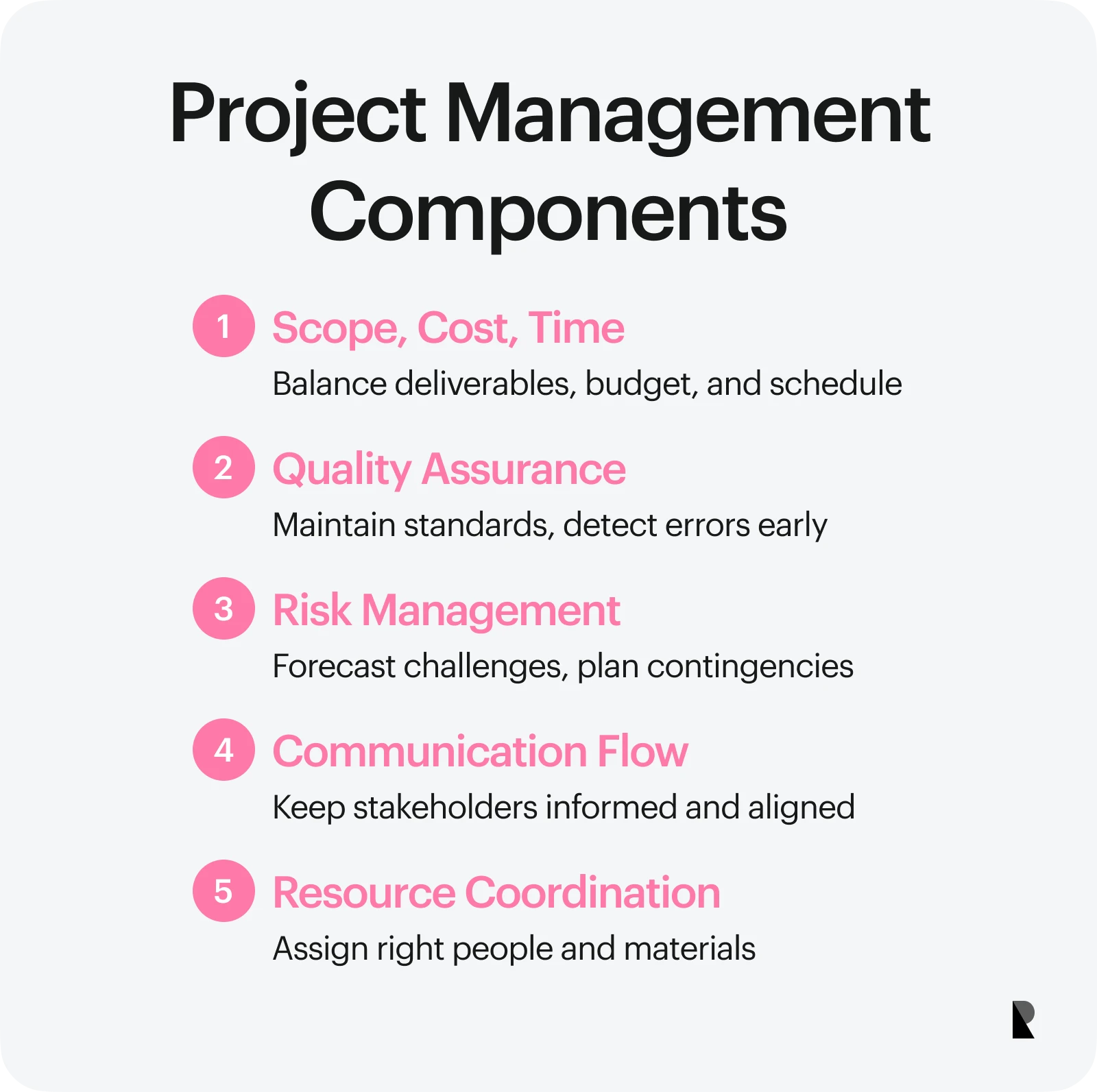
Scope, cost, and time management
Defining the scope, setting the cost, and establishing time are often called the triple constraint. This is because properly balancing these three elements requires a delicate touch.
Scope encompasses the deliverables, tasks, and other work required for the project. The larger the scope, the more resources and team members are needed.
Cost is the budget for materials, labor, and other expenses to accomplish said tasks. If the scope is expansive, the final project budget increases accordingly. Time is the duration of completing the project, wherein reducing the scope or adding a budget can accelerate the timeline.
Effective project management requires clearly defining the work, carefully planning the schedule, and monitoring the budget and resources closely.
Quality assurance and risk management
Quality assurance ensures a project is completed precisely from start to finish. It can be achieved by setting standards and periodically checking the quality of output delivered. Quality assurance also helps project teams identify and correct mistakes as they occur.
Risk management involves planning and forecasting potential problems in a project and devising creative solutions to address or prevent them. When risk management is successful, it can protect the organization from losing time, money, and reputation.
Communication and resource coordination
All the elements of a project need to work together seamlessly. Effective communication helps you achieve this by keeping everyone involved and informed, aligning expectations with the overall business goals, and resolving issues promptly.
Moreover, resource coordination in project management ensures the business hires the right people and has access to the materials and other supplies needed to complete the project successfully. In effect, project managers can meet deadlines and the expectations of stakeholders and sponsors.
Project Management Lifecycle Stages

The project management lifecycle is a blueprint for turning your idea into a successful project. Its main stages are: initiation, planning, execution, monitoring progress, and closing.
Initiation: defining vision and goals
Before kicking off a project, take the time to define your vision and goals. These will serve as your compass, guiding you on what needs to be done and helping you understand your stakeholders' real interests and concerns.
Consider the "why" in every project. What problems are you trying to solve or opportunities you can explore? Moreover, the project manager's authority must be established and communicated clearly to the team.
Planning: structuring tasks and timelines
At this stage, structure tasks based on available resources and timelines. Part of planning involves preparing contingency strategies for potential issues.
The planning process is ever-evolving, especially for projects with an enormous scope. So don't be afraid to start with a rough project plan and refine it as you go. Use planning tools, like Gantt charts and Work Breakdown Structure (WBS), to improve efficiency.
Weave in a feedback loop between team members and keep everyone updated. More importantly, it is essential to plan to capitalize on any unexpected benefits, not just mitigate risks.
Execution: managing teams and deliverables
It's time to turn your project plan into action. Once you have broken down the goals into milestones and have created a structure, you must delegate them to your team members.
While project management is vital in ensuring everyone does their job correctly, keep your team empowered by allowing them enough room for flexibility and creativity. But don't let new ideas derail the original project plan without proper review. It is also essential to keep your team motivated by celebrating small wins and giving rewards.
Monitoring and controlling progress
Constant monitoring is necessary to identify and address problems early before they cause significant issues for your team. Maintain open communication and regularly engage with your team and stakeholders to gather feedback. You can also track your progress against your set Key Performance Indicators (KPIs), schedule, cost, and scope to see if you have veered away from them.
Other strategies that help enhance project visibility, control, and adaptability include:
- Critical Path Method
- Earned Value Management
- Centralized Project Management Platforms
Closing: deliverables and lessons learned
Next, wrap up the project, deliver the final product, and learn from what happened! The project management lifecycle should end with realizations you can carry on to the next project. So, document lessons about what worked and what didn't to improve future projects.
Finally, celebrate project success with your team to boost morale.
Key Roles in Project Management
Building a strong and efficient project management team is crucial in achieving project success. It is essential to find the right people with the necessary skills, relevant certifications from the Project Management Institute, and experience needed for the project. They should also clearly understand the set goals and their roles and responsibilities.
Moreover, an effective project management team has people who can communicate and collaborate well with each other, creative problem solvers, and value lifelong learning. These qualities help the team grow and improve for the next project.
Project manager as a coordinator
The project manager steers the team towards the finishing goal. They are responsible for picking the right people, aligning everyone's efforts, and meeting project expectations.
They are skilled at troubleshooting problems and leveraging the expertise of every team member. They can maintain efficient communication to identify challenges early.
Project managers are adept at guiding the team from start to finish, capitalizing on their versatility and deep understanding of what is needed to deliver success.
Stakeholders and project sponsors
Stakeholders can be anyone directly interested in a project, including employees, board members, end-users, and external entities. They provide an outside perspective by offering feedback on what they like and don't like about the project.
Most stakeholders don't make big decisions, but a group does: the sponsors. Sponsors are high-level stakeholders. Think of the CEO, CFO, or COO, who select the project manager, approve the budget, and make other crucial decisions.
Project team members and their functions
A project management team typically comprises members with the necessary skills and experiences to deliver results. Suppose you are a project management team in a tech firm. In that case, you can expect developers, analysts, and designers to participate. Other possible members of a project management team are the following:
- Resource manager: Depending on the project's size, a resource manager may be necessary to assist the project manager in hiring the right people and allocating resources effectively to optimize results.
- Assistant project manager: Assists the project manager with daily tasks, such as tracking progress and organizing meetings.
- Business analyst: Responsible for gathering insights that help the project team determine the best strategies and utilize the appropriate tools.
- Subject matter experts (SMEs): These are industry experts with substantial knowledge in a specific subject vital to the project.
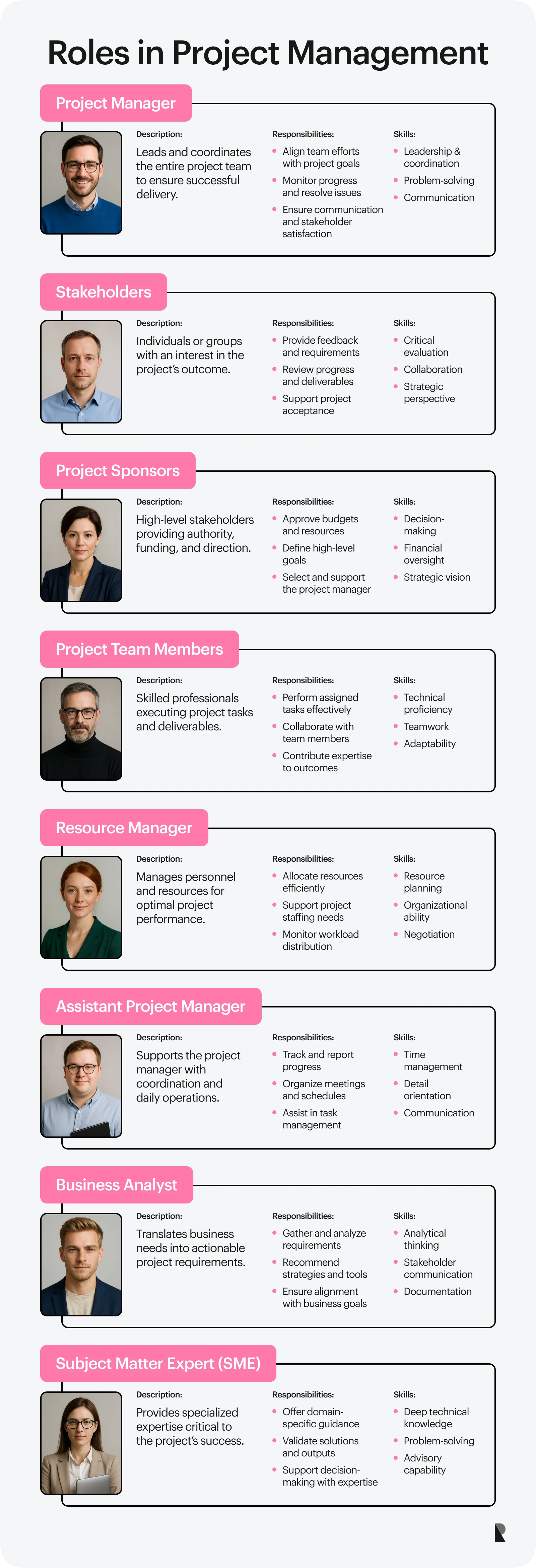
Popular Project Management Methodologies
Your decision on which types of project management to apply depends on the nature and complexity of your project. Let’s explore some of the most popular methods and see which suits your needs.
Waterfall: sequential approach
Waterfall project management is a methodology that follows a single sequence, like a waterfall flowing down in one direction from one level to another. This means ensuring one phase is completed before moving on to the next. Applied to a project, the waterfall approach divides the process into phases: planning, implementation, testing, deployment, and maintenance.
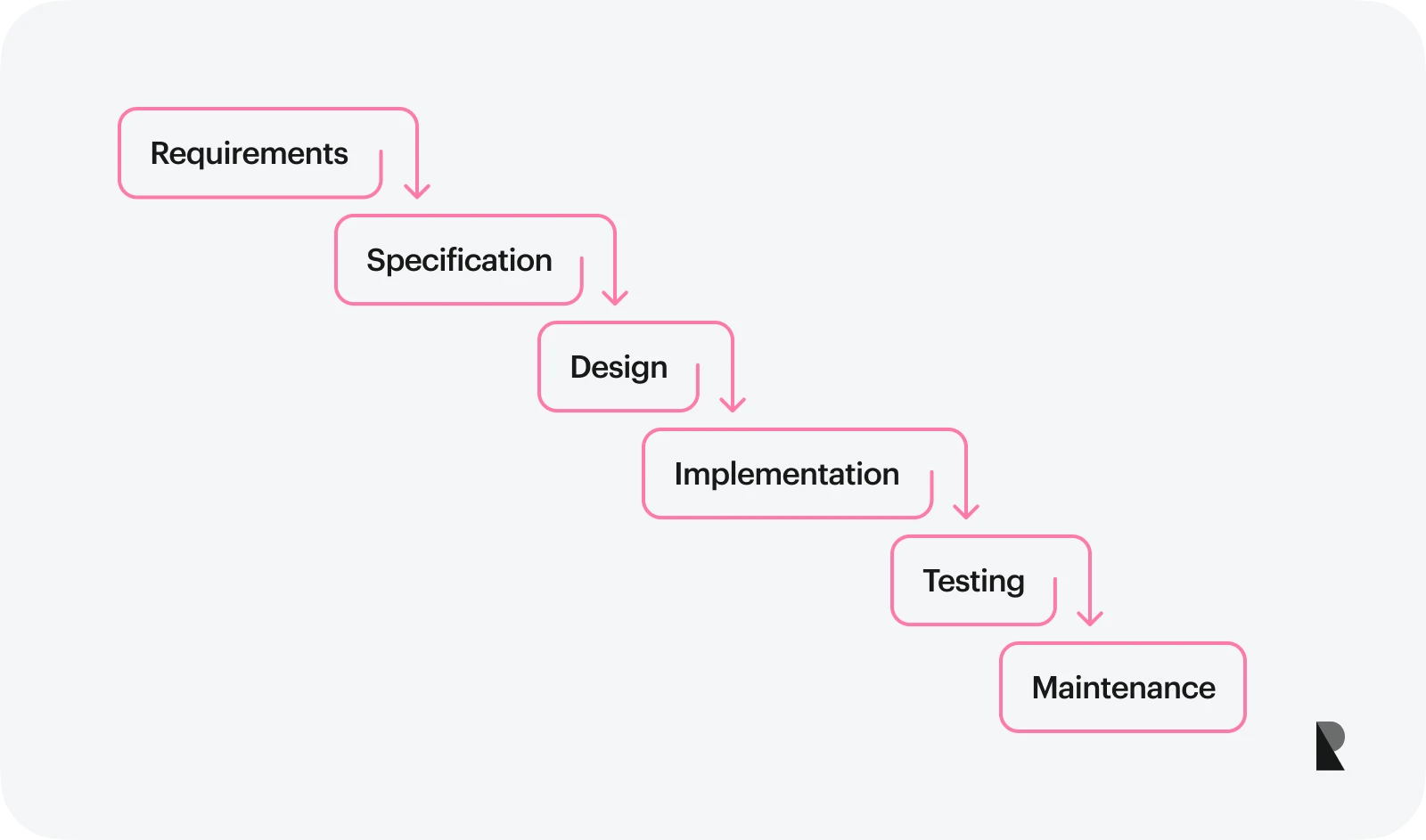
Say you’re tasked with creating a website for a photography business. The waterfall approach begins by defining the project requirements of a website, from purpose and target audience to functional needs, website expectations, and content types.
Next, the project team moves to the design phase, creating visual mockups and mapping the user experience flow. This is followed by the implementation stage, where programmers build the necessary code, integrate galleries, and upload content. Finally, the website undergoes testing before its official launch, after which updates and bug fixes are made.
Why choose this project management methodology?
Waterfall methodology ensures a fixed timeline and a budget with clear deliverables at every stage. This approach is best if the project is straightforward and has a short timeline.
Agile: iterative and adaptive
Agile project management enables teams to quickly complete projects by breaking them into smaller phases. Instead of planning everything from start to finish, teams work in short cycles. This allows the team to plan, build, test, and receive feedback at every stage, which increases efficiency.
Now, there are two commonly used methodologies under the agile principle: Scrum and Kanban.
Scrum methodology
Scrum lets teams work in sprints, where mini-goals are assigned in a specific timeframe. For example, the scrum master's first sprint task assigns the dev team to create the first stage of a game app within one week. At the end of the week, the dev team must present a demo of the app and ask for feedback before proceeding to the next phase. As a result, every sprint is better than the last as they constantly adapt to improvements.
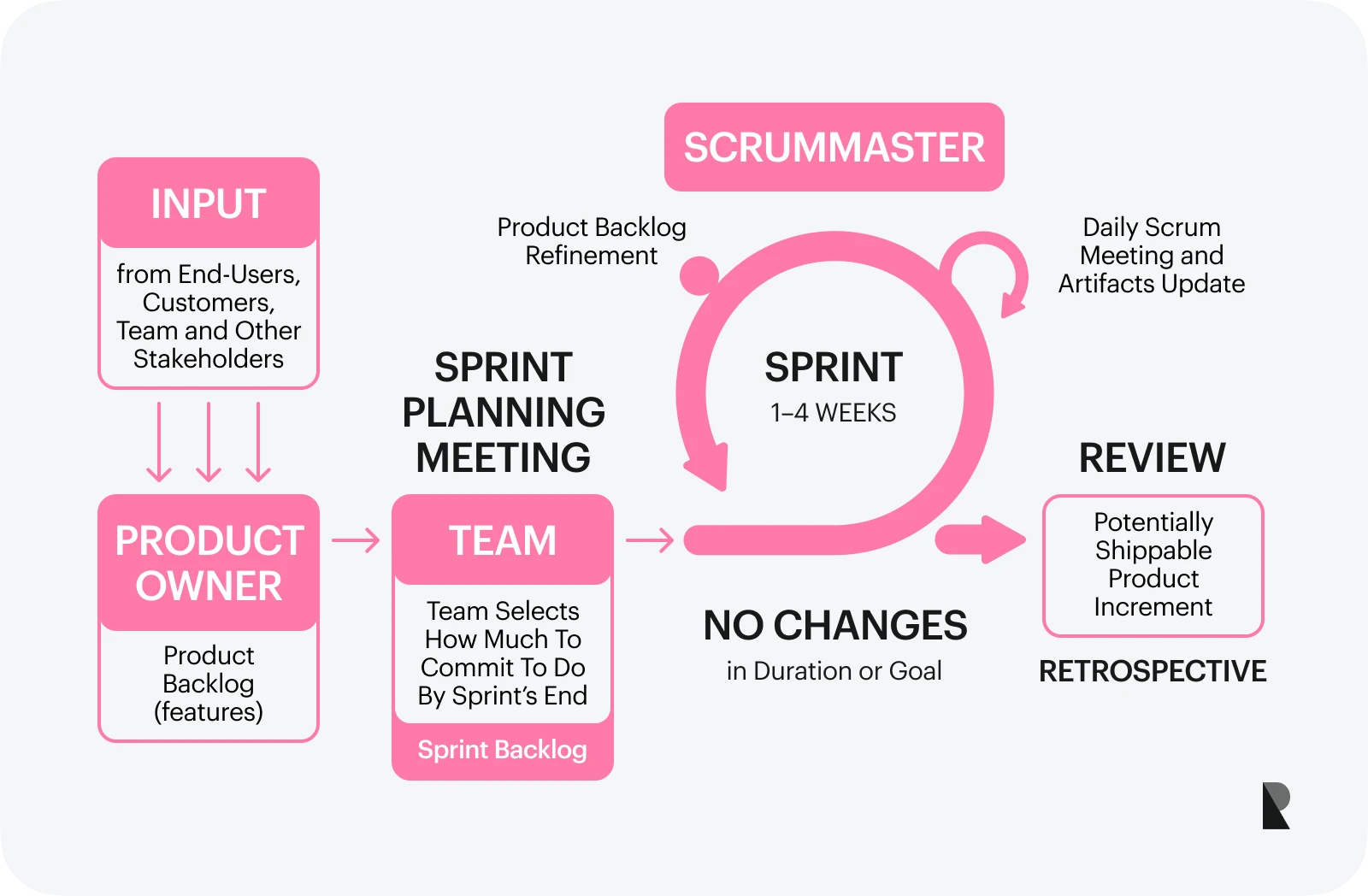
Kanban methodology
The Kanban methodology focuses on streamlining tasks, similar to a to-do list, into different categories. Contrary to the Scrum method's timeboxes, Kanban prioritizes continuous flow by visualizing work in progress on the Kanban board.
For example, the Kanban board may split tasks into: To-Do, In Progress, and Done. You then limit the number of project tasks that can progress at any given time. This continuous flow prevents team overload, ensuring tasks are completed more efficiently.
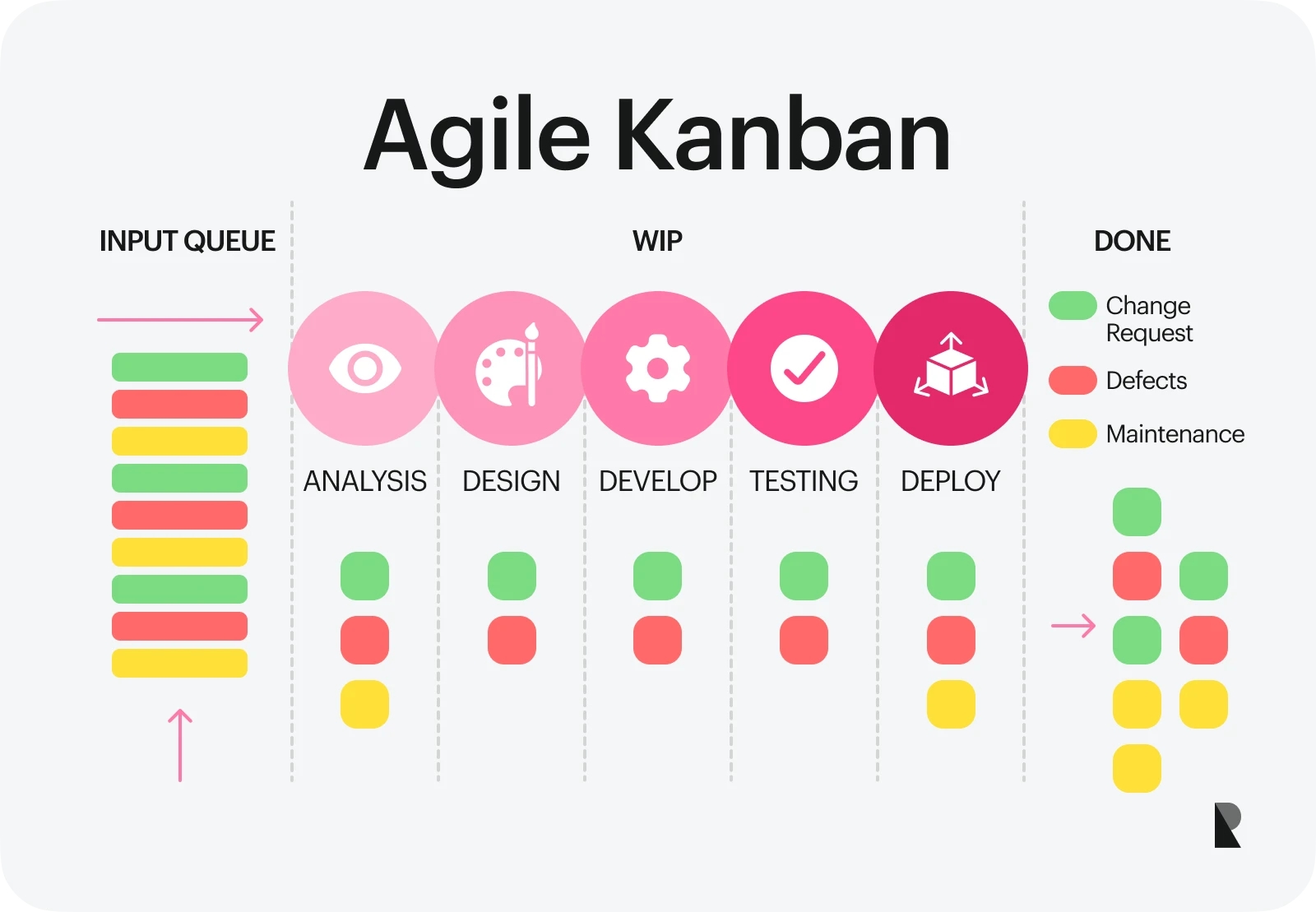
Teams working with agile methodology must collaborate closely at every step. This dynamic involves meetings and consultations as they regularly work on various project components.
For instance, when a company develops an app for its end-users, an agile project team must release each page to gather user feedback and iteratively improve the app.
Why choose this project management methodology?
It keeps the project team flexible, allowing them to adjust at every stage, test ideas quickly, and improve them based on feedback. This way, you don't waste time and resources on things no one likes, and finish projects quicker.
Lean: efficiency and value focus
The lean approach requires identifying steps that add value and removing unnecessary tasks to speed up the process. Issues include excessive inventory, delivery delays, and inefficient personnel. This project management methodology was pioneered by Toyota, where engineers developed a system enabling them to produce cars faster, cheaper, and better through a lean process.

Of course, this approach entails knowing precisely what the customers want and delivering it as expected—no fluff, no additional cool features that they don't need.
If you are building a menu for a restaurant, applying the lean method means adding only what's popular among customers and sticking to a few items. A menu with two appetizers, four main dishes, and two desserts. This way, the kitchen doesn't get overwhelmed and can focus on delivering high-quality dishes to customers.
Why choose this project management methodology?
Lean project management methodology is excellent for tight budgets and timelines. You can’t afford to waste resources and want to focus on speed and quality. It’s beneficial in projects where quick turnaround and customer satisfaction are a priority.
Essential Project Management Tools and Software
Asana
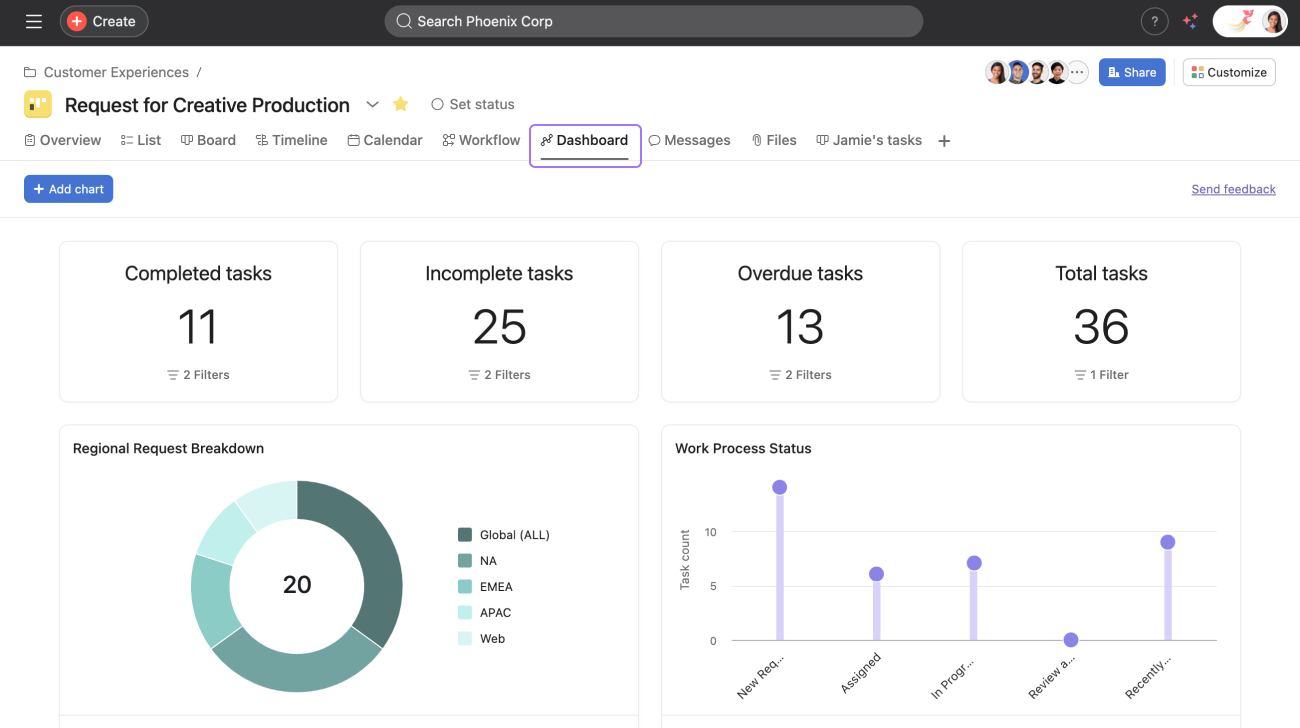
Asana dashboard via Asana
Asana is a versatile project management tool that is accessible on the web and mobile. Its key features are project creation and task assignment, deadline management, and collaboration tools that allow for comments and real-time feedback. Asana's project dashboard provides an overview of project status and team productivity.
While Asana is a comprehensive tool for larger teams, its extensive features may overwhelm smaller projects. Users should use Asana's core features to stay organized and on track.
Trello
Trello is a visually appealing and user-friendly project management alternative to Asana. It represents projects through visual boards where you can easily drag-and-drop task cards across sections as you progress. This intuitive Kanban-style approach makes it simple to track progress at a glance.

Trello dashboard via Trello
Trello's customizable boards allow you to add colors and have fun with emojis and other visual elements. At the same time, the collaboration features enable seamless teamwork through tagging and commenting. However, the app may lack advanced reporting capabilities like Gantt charts, and its visual nature can lead to cluttered boards for more complex projects.
Jira
Another agile-based project management tool is Jira, which caters to more complicated projects, especially in software development and IT. It has advanced issue tracking features and can be tailored for complete user control. Jira can also support Scrum and Kanban frameworks and provide real-time reporting.

Jira dashboard via Atlassian
Common Challenges in Project Management
Scope creep and missed deadlines
Scope creep occurs when a project balloons beyond the set scope. Adding more tasks and goals without prior approval can lead to higher project costs and missed deadlines.
Scope creep stems from poor planning, where project goals are not identified clearly. There's a communication gap between members, with some overriding authority. Some stakeholders are not on the same page and want different things from the project.
You can avoid this by pinning down specific goals and scope early in the planning stage. Establishing a request and feedback system to prevent unauthorized changes is also crucial.
Limited resources and budget constraints
Balancing limited resources and budget constraints with project goals can be difficult. You can't spend more than what's available. Sometimes, you don't have the right experts in your team to perform the job.
That said, focus on the project's most critical tasks first and allocate available resources there. Consider factoring in a contingency fund in your overall budget if something goes wrong. Finally, leverage software or apps to help organize resources.
Get Started in Project Management
Project management has become a must-have in today's fast-paced and complex environment. A survey shows that more than 80% of companies implement project management tools. However, it requires the right combination of tools, strategies, and people to improve efficiency, reduce risks, and turn ideas into tangible results.
As you build your project management team, look for people with unique technical skills, creative thinking, and strong communication abilities. Focus on creating a collaborative environment where everyone can contribute ideas and provide feedback. An empowered team that embraces lifelong learning can significantly improve your project management approach and strategies, leading to exceptional results.
Sep 16, 2025
